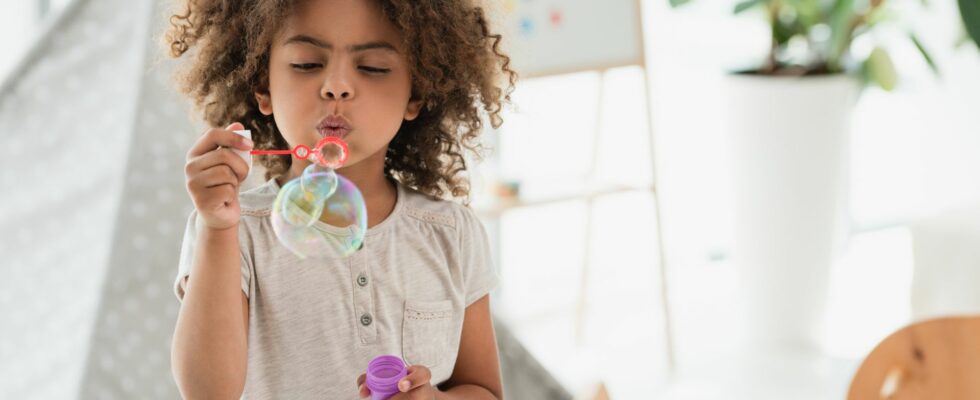Creating big, beautiful soap bubbles is a science. This is the perfect recipe for soap bubbles, by physicists, in The Conversation.
When a child spills the liquid from his toy to make bubbles, it is often replaced by dishwashing liquid and… it works less well. Is there a better recipe for making soap bubbles? Specialists in this question are the artists who manipulate the bubbles in their shows. One of them gave us an oft-used recipe so we could better understand the physical mechanisms behind it.
We had to identify which well-controlled experiment makes it possible to test the recipes. This experiment must be reproducible, that is to say give the same result if it is repeated several times in a row. We therefore worked at a constant temperature and air humidity. Indeed, these parameters are very important, because they modify the evaporation rate of the liquid. Soap bubbles are made up of a thin film of liquid that encapsulates air. If this film becomes too thin, the bubble bursts more easily. So the higher the evaporation rate, the faster the liquid evaporates, the thinner the film and the faster the bubble bursts.
How much dishwashing liquid to make soap bubbles?
We identified two different experiences. In the first, we place a soap bubble on a surface and measure its lifetime. This makes it possible to measure the stability of the bubble for a given recipe. In a second experiment, we dip a plastic ring in a soapy liquid and always blow into it with the same speed thanks to a pressure controller. We count the number of bubbles thus created.
The surprising result of our study is that the recipes that give bubbles that last a long time are not necessarily those that allow you to make many bubbles. Good recipes are the result of a compromise. Thus, we know that you have to put dishwashing liquid to make soap bubbles. It is he who contains the soap molecules. If you put little, the bubbles last a long time, but they are difficult to form. If you put too much, you can make many bubbles that burst very quickly. It is the compromise between these two observations that leads to the amount of dishwashing liquid used by the artists: 4% by volume i.e. 40 mL of dishwashing liquid in 960 mL of water for the particular dishwashing liquid that We studied.
It is then possible to add ingredients which make it possible to improve either the stability or the ease of generation of the bubbles. To have more stable bubbles, you can add 10% glycerol, that is to say 100 mL for 900 mL of dishwashing liquid/water mixture. It is a liquid widely used in cosmetics because it preserves products from drying out by preventing the evaporation of the water they contain. You can find it in pharmacies. However, as explained above, one way of delaying the bursting of the bubble is precisely to reduce evaporation.
To make the bubbles easier to make, we can add long molecules (called polymers) which will behave like long threads inside the soap film. With guar gum, a food additive which makes it possible to gel the preparations, it is necessary to put just one gram. When the bubble is made, the film on the plastic ring must deform to become a bubble. It then becomes very thin and the long threads will organize themselves parallel to the surface in the film. They will thus prevent it from breaking during its manufacture.

The recipe for soap bubbles, in brief
Dilute 1 gram of Guar gum in a little glycerin and add 40 mL of dish soap (choose a dish soap containing 15-30% anionic surfactants or double the dose, check the product label) and 100 mL of glycerine . This preparation can be kept for a few days. At the last moment, add 860 mL of water to have 1L of solution.

This article is the result of a collaboration with the bubbler artist Pierre-Yves Fusier and Laura Wallon.
Emmanuelle Rio, Teacher-Researcher, Paris-Saclay University; François Boulogne, Researcher in soft matter, National Center for Scientific Research (CNRS); Frédéric Restagno, Physics, Paris-Saclay University and Marina Pasquet, Postdoctoral student in physics, University of California, Berkeley
This article is republished from The Conversation under a Creative Commons license. Read the original article.
If you liked this article, you will like the following ones: do not miss them by subscribing to Numerama on Google News.
